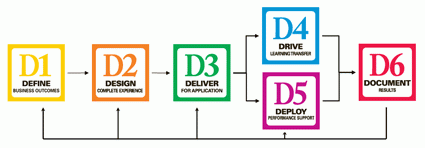The three titans of learning, Roy Pollock, Andrew Jefferson, and Calhoun Wick have done it again, recently publishing The Field Guide to the 6Ds as follow up to their best-selling Six Disciplines of Breakthrough Learning. This substantial book isn’t meant to be read cover-to-cover (which is a relief, since the authors have jokingly compared it to Moby Dick), but instead it serves as a what’s-what reference tool for business leaders who are looking to squeeze more value out of their organization’s sales training investments.
The guide is extremely user-friendly: it features four sections, beginning with an overview of the six disciplines, followed by tools instrumental in implementing the 6Ds, real-life case studies exemplifying each of the disciplines, and finishing with how-to guides on selected topics.
You may already be familiar with the 6Ds:

D1: Define Business Outcomes
D2: Design the Complete Experience
D3: Deliver for Application
D4: Drive Learning Transfer
D5: Deploy Performance Support
D6: Document Results
When executed together, these disciplines can kick your sales enablement programs into high gear, resulting in overall performance improvement within your sales force. The opportunity to develop is continuous, as managers use measured results from D6 to further improve application of the other disciplines in future initiatives.
In the book’s introduction, the authors highlight the simple fact that “training creates value only to the extent that it is transferred and applied to work in a way that improves performance.” In our experience, we find that the biggest opportunity to punch up sales effectiveness lies within the reinforcement of learning transfer, or D4. Hundreds of thousands of dollars are invested in training your sales force, but what’s going to happen when your reps go back into the field?
The six disciplines postulate that 80% of the link from training to application on the job is lost. What a waste of resources, you say? In order for that new knowledge to be leveraged with the customer, where it matters most, managers must establish systems and processes that reinforce critical knowledge and selling skills. The 6Ds suggest this can be accomplished by reminding reps continuously of the new knowledge, whether in the format of tips, questions or additional materials.
While this guide boasts over 40 case studies that represent each of the 6Ds in action, we’re particularly excited that Qstream is featured in a case supporting D4. The case study describes how one of the world’s largest pharmaceutical companies prepared a team of over 3, 000 reps for the launch of one of the company’s most profitable drugs into the U.S. market. With fierce competition and regulatory risks to manage, brand managers simply couldn’t afford to have sales reps unprepared. Instead they introduced Qstream in what they described as a “game changer”. By combining the elements of interval reinforcement, active recall and gamification in Qstream, the company was able to maintain market share, and effectively grow sales of the drug by six percent that year. Because reps remained engaged – claiming Qstream was ‘addictive’ – they were able to recall the critical content they needed to win.
The takeaway
Qstream fits into your busy team’s schedule, filling the gap between training and application without taking reps out of the field. Real-time analytics provide managers with valuable insights that can be turned into targeted coaching opportunities for reps who are struggling. At the end of the day, driving relevant business outcomes is the number one goal for managers. With Qstream, your sales force knows more, sells more and isn’t wasting precious customer face time in repeated training programs that aren’t sticking.
Request a demo of Qstream today.






